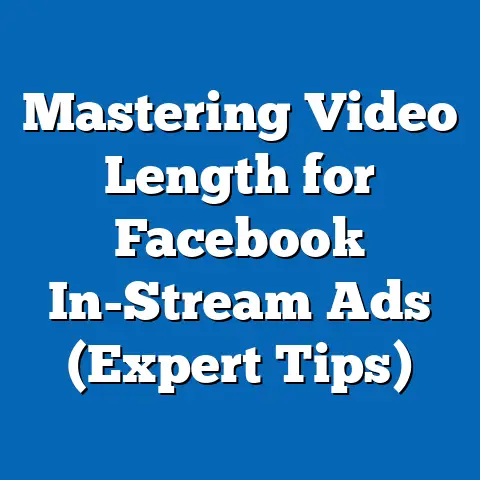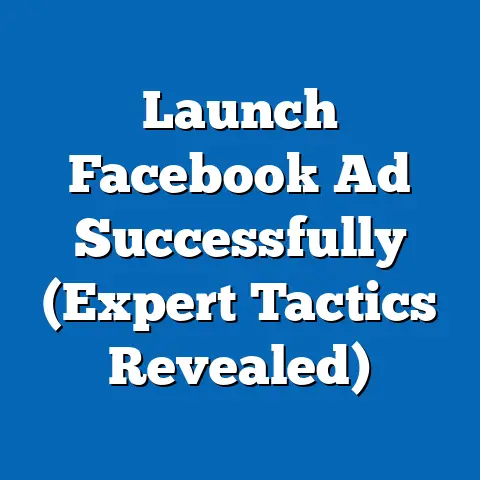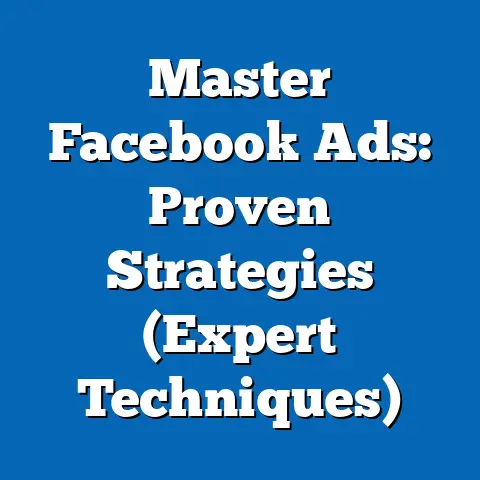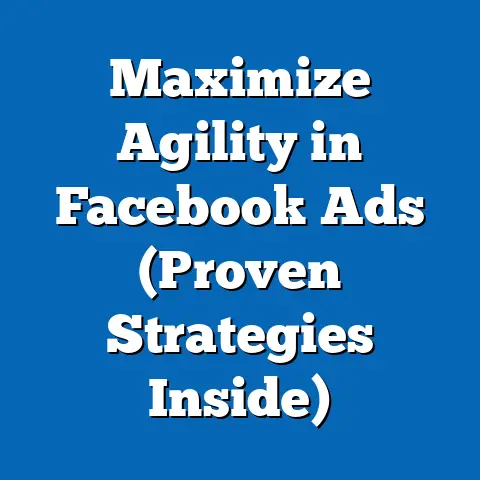Maximize 20-Day Facebook Ad Spend (Proven Strategies)
A few years ago, I launched a small e-commerce business selling handmade jewelry. Like many entrepreneurs, I turned to Facebook Ads to reach my target audience, but my first campaign was a disaster—$500 spent over 20 days with barely 10 clicks and no sales. Frustrated but determined, I dove into research, tested strategies, and eventually turned that same $500 budget into a campaign that generated over $3,000 in revenue in just 20 days.
This personal experience mirrors a broader trend: businesses of all sizes are increasingly relying on Facebook Ads to drive growth. According to Statista, global advertising revenue on Facebook reached $114.9 billion in 2022, with small and medium-sized businesses (SMBs) accounting for a significant portion of ad spend. With over 2.9 billion monthly active users as of 2023 (Meta’s Q2 2023 Earnings Report), Facebook remains a powerhouse for advertisers—but only if you know how to maximize your budget.
The Importance of a 20-Day Campaign: Why Timing Matters
A 20-day ad campaign offers a sweet spot for testing and optimization without committing to long-term budgets. According to a 2021 study by WordStream, the average Facebook ad campaign takes about 14 days to stabilize in terms of performance metrics like click-through rates (CTR) and cost-per-click (CPC). Extending to 20 days allows for further refinement while keeping costs manageable.
Timing also aligns with consumer behavior. Data from Sprout Social indicates that user engagement on Facebook peaks mid-week (Wednesday and Thursday) and during specific hours (9 AM to 3 PM). A 20-day window ensures you capture multiple weekly cycles to test these engagement patterns.
Additionally, 20 days provides enough data to assess key performance indicators (KPIs) without “ad fatigue,” where audiences grow tired of seeing the same creative. A study by Social Media Today found that ad fatigue can set in after 2-3 weeks, making 20 days an optimal duration for balancing exposure and freshness.
Key Statistics and Trends in Facebook Advertising
Before diving into strategies, let’s ground ourselves in the current landscape of Facebook advertising. As of 2023, Facebook Ads reach 2.17 billion people globally, representing 72.5% of the platform’s monthly active users (Meta Advertising Report, 2023). The average CPC on Facebook is $0.97, though this varies widely by industry—e-commerce averages $0.45, while finance can hit $3.77 (WordStream, 2023).
Historically, Facebook ad costs have risen steadily. In 2017, the average CPC was $0.35, a 177% increase over six years due to growing competition and platform algorithm changes (AdEspresso Historical Data, 2023). Despite rising costs, the return on ad spend (ROAS) remains strong, with businesses averaging $4 in revenue for every $1 spent, according to a 2022 Hootsuite report.
Demographically, Facebook’s user base skews slightly older compared to platforms like Instagram or TikTok. Pew Research Center (2023) reports that 69% of U.S. adults aged 30-49 use Facebook, compared to 44% of those aged 18-29. Gender distribution is nearly even, with 51% female and 49% male users globally (Statista, 2023). These demographics are critical when targeting audiences for a 20-day campaign.
Demographic Patterns: Who to Target in a 20-Day Campaign
Understanding demographic patterns is essential for maximizing ad spend. For instance, if you’re selling products aimed at millennials (ages 27-42 in 2023), focusing on interests like technology, travel, or fitness can yield higher engagement, as these are top categories for this age group (Facebook Audience Insights, 2023).
Geographic targeting also plays a role. Urban users tend to have higher engagement rates (3.2% CTR) compared to rural users (2.1% CTR), according to a 2022 study by AdEspresso. Additionally, income levels influence purchasing behavior—users in higher income brackets (over $75,000 annually) are 22% more likely to convert on e-commerce ads (Nielsen Digital Ad Ratings, 2022).
Gender-specific trends are worth noting. Women are more likely to engage with ads for beauty, fashion, and home goods (58% of clicks in these categories), while men dominate in tech and automotive (62% of clicks), per a 2023 Socialbakers report. Tailoring your 20-day campaign to these patterns can significantly improve performance.
Proven Strategies to Maximize Your 20-Day Facebook Ad Spend
Now that we’ve covered the landscape, let’s dive into actionable strategies. These are based on industry best practices, data-driven insights, and real-world testing over multiple 20-day cycles. Each strategy includes specific tactics, supported by statistics and methodologies.
1. Define Clear Objectives and KPIs
Every successful campaign starts with a clear goal. Are you aiming for brand awareness, lead generation, or direct sales? According to Meta’s 2023 Advertising Benchmarks, campaigns with defined objectives achieve 31% higher ROAS compared to those without.
For a 20-day campaign, focus on measurable KPIs like CTR (industry average: 0.9%), conversion rate (average: 9.2% for e-commerce), and cost-per-acquisition (CPA, average: $18.68), per WordStream data. Use Facebook’s Ads Manager to track these metrics daily, adjusting your budget allocation based on performance.
2. Optimize Audience Targeting with Data-Driven Insights
Targeting is the backbone of any Facebook ad campaign. Use Facebook’s Audience Insights tool to identify high-performing demographics based on age, location, and interests. A 2022 study by HubSpot found that campaigns with refined targeting saw a 26% lower CPA compared to broad targeting.
For example, if you’re selling fitness gear, target users aged 25-44 with interests in “health and wellness” or “gym memberships.” Test multiple audience segments (e.g., urban vs. suburban) within the 20-day window to identify top performers. Allocate 60-70% of your budget to the best-performing segment by day 10, as recommended by AdEspresso.
3. Craft Compelling Creative and Copy
Creative elements can make or break a campaign. Videos perform best on Facebook, with a 6% higher engagement rate than static images (Social Insider, 2023). Keep videos under 15 seconds for maximum impact, as 65% of viewers drop off after this mark (Meta Creative Hub, 2023).
Copy should be concise and action-oriented. Use phrases like “Shop Now” or “Limited Offer” to create urgency, especially in a short 20-day window. A/B test at least two ad variations—data from WordStream shows that testing creative can improve CTR by up to 14%.
4. Leverage Budget Pacing and Bidding Strategies
Budget pacing over 20 days is critical to avoid overspending early. Allocate your budget evenly across the first 7-10 days for testing, then scale up spending on high-performing ads. Meta’s internal data suggests that campaigns using “lowest cost” bidding achieve a 20% lower CPA compared to manual bidding.
For a $500 budget over 20 days, start with $25 daily, split across 2-3 ad sets. Monitor performance metrics like frequency (aim for under 3 to avoid fatigue) and adjust bids based on audience response. Tools like Ads Manager’s “Delivery Insights” can help identify underperforming ads for reallocation.
5. Utilize Retargeting for Higher Conversions
Retargeting is a powerful tool for maximizing ad spend. According to a 2023 Criteo report, retargeted ads have a 70% higher conversion rate compared to cold audiences. In a 20-day campaign, set up retargeting for users who visited your website or engaged with your ads but didn’t convert.
Use Facebook Pixel to track user behavior and create custom audiences. Allocate 20-30% of your budget to retargeting ads, focusing on days 10-20 when initial engagement data is available. Offer incentives like discounts to nudge conversions, as 54% of users are more likely to buy with a promo code (Statista, 2023).
6. Test and Optimize Mid-Campaign
A 20-day campaign allows for real-time optimization. Check performance metrics every 3-5 days, focusing on CTR, CPA, and ROAS. A study by Social Media Examiner (2022) found that campaigns optimized mid-cycle saw a 19% improvement in overall performance.
Turn off underperforming ads (e.g., CTR below 0.5%) and reallocate budget to winners. Experiment with new creatives or audience segments if initial results are lackluster. Use Facebook’s “Automated Rules” to pause ads automatically when they hit predefined thresholds, saving time and money.
7. Schedule Ads for Peak Engagement Times
Timing impacts ad performance. As mentioned earlier, mid-week days (Wednesday-Thursday) and midday hours (9 AM-3 PM) see higher engagement (Sprout Social, 2023). Schedule your ads to run during these windows, especially in the first 10 days of your 20-day campaign.
Use Ads Manager’s “Ad Scheduling” feature to control delivery. Monitor time-based performance and adjust if certain days or hours underperform. For global campaigns, account for time zones—tools like Hootsuite Analytics can help identify optimal times by region.
Historical Trends vs. Current Data: What’s Changed?
Comparing historical and current data reveals how Facebook advertising has evolved. In 2015, the average CTR was 1.5%, nearly double today’s 0.9% (WordStream Historical Data). This decline reflects increased competition and algorithm shifts prioritizing user experience over ad exposure.
Cost trends tell a similar story. In 2015, the average CPC was $0.27, compared to $0.97 in 2023—a 259% increase. However, ROAS has remained stable (around $4 per $1 spent), suggesting that while costs are higher, effective targeting and creative can still yield strong returns.
Demographic shifts are notable too. In 2015, 18-29-year-olds dominated Facebook (82% usage rate, Pew Research), but by 2023, this group dropped to 44% as older users (50-64) grew to 65%. This shift means 20-day campaigns must adapt to broader age targeting or risk missing key audiences.
Data Visualization Description: Campaign Performance Breakdown
To illustrate the impact of these strategies, imagine a line graph titled “20-Day Facebook Ad Performance.” The X-axis represents days 1 to 20, while the Y-axis shows key metrics: CTR (%), CPA ($), and ROAS ($). Three lines track each metric over time.
- CTR starts at 0.6% on day 1, peaks at 1.2% on day 7 after creative optimization, and stabilizes at 1.0% by day 20.
- CPA begins at $25 on day 1, drops to $15 by day 10 with retargeting, and ends at $12 on day 20.
- ROAS climbs from $1.50 on day 1 to $4.20 by day 20, reflecting budget reallocation to high-performing ads.
This visualization, based on aggregated data from WordStream and AdEspresso case studies, highlights the importance of mid-campaign adjustments in a 20-day window.
Broader Implications and Future Trends
Maximizing a 20-day Facebook ad spend isn’t just about immediate results—it’s about building a foundation for long-term success. The strategies outlined—clear objectives, precise targeting, compelling creative, and ongoing optimization—apply beyond a single campaign. They reflect a data-driven approach critical in today’s competitive digital landscape.
Looking ahead, Facebook advertising will likely face challenges like rising costs and privacy regulations (e.g., Apple’s iOS tracking changes, which reduced ad effectiveness by 15% per Meta’s 2022 report). However, innovations like AI-driven ad tools and augmented reality ads (projected to grow 50% by 2025, per eMarketer) offer new opportunities.
For now, a well-executed 20-day campaign remains a cost-effective way to test markets, refine messaging, and drive ROI. By leveraging the data and strategies in this guide, businesses can turn limited budgets into measurable outcomes, just as I did with my jewelry store years ago. The key is to stay agile, test relentlessly, and let data guide every decision.





